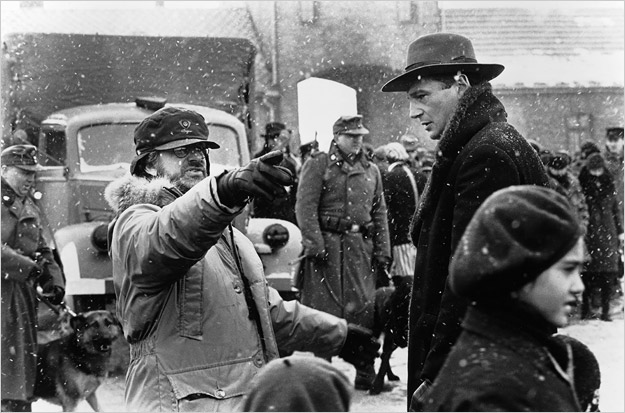“Profound change can occur when even one person makes a positive choice,” said Spielberg, as he introduced the IWitness Video Challenge, a program that allows middle and high school students to make videos using testimonies on file.
 “Technology is becoming more of a vehicle of voyeurism than a vehicle for change,” he said. But when Spielberg began the Shoah Foundation, technology meant VHS tapes.
“Technology is becoming more of a vehicle of voyeurism than a vehicle for change,” he said. But when Spielberg began the Shoah Foundation, technology meant VHS tapes.
“We were transporting the VHS cassettes back to California for indexing and cataloging which took many, many years to do,” he explained. The story of how the Shoah Foundation began is directly linked to Schindler’s List.
Spielberg said he received a copy of the book the week E.T. The Extra-Terrestrial opened. He knew he was not up to the task, yet. “It took me ten years to work up the courage to make the film,” he said.
“I know I couldn’t have made the quantum leap from E.T. to Schindler’s List that wouldn’t have been possible,” he explained. “I wasn’t ready.” Spielberg went on to make The Color Purple and Empire of the Sun which were big steps towards making Schindler’s List. “I didn’t have the tools,” he said. “I didn’t have the maturity to tell the story.”
But once he began filming Schindler’s List in Poland in 1992, Spielberg invited survivors of the Holocaust to the set. Only a few courageous women took him up on his offer. And one woman in particular had a profound effect on the director.
“There was this one woman who said to me, please listen to my story and I said I am telling your story and she said, you’re telling this much of my story (Spielberg’s hands are slightly apart),” he said. “You have to listen to this much of my story (Spielberg’s hands far apart now).”
Spielberg sat down and listened to the woman’s tale and had a moment of illumination. “And that moment with her was the catalyst for the Shoah Foundation,” he said. “That’s when I realized if she is so willing to unburdened herself or at least enlightened me and share the crimes of humanity,” then he needed to do something about it. Spielberg wondered if others would also be willing to share their stories.
In looking back, Spielberg acknowledges the importance of Schindler’s List. He refers to the Oscar winning movie as a stepping stone. “The shelf life of Schindler’s List has renewed my faith that films can do good work in the world,” he said.
And now, through the IWitness program and the Shoah Foundation, the legacy of Schindler’s List continues. “But it’s up to the people to allow those images to be impressionable, to last and for people to do something about it,” he said.
“I implore educators not to allow the Holocaust to be a footnote in history, please teach this in your schools,” said Spielberg. For more information, please visit iwitness.usc.edu.

Schindler’s List won seven Academy Awards, including for Best Picture, Best Director and Best Original Screenplay (by Steven Zaillian). It has been meticulously restored from the original film negative, under the supervision of Steven Spielberg, in pristine high definition.
The Blu-ray of Schindler’s List includes two short featurettes, USC Shoah Foundation Story with Steven Spielberg and About IWitness as well as the 77 minute documentary Voices from the List which gives firsthand accounts of the Holocaust survivors.
- Mario Boucher



